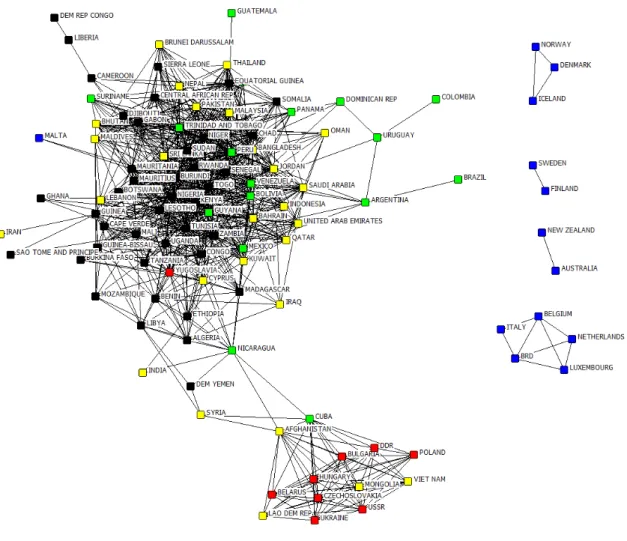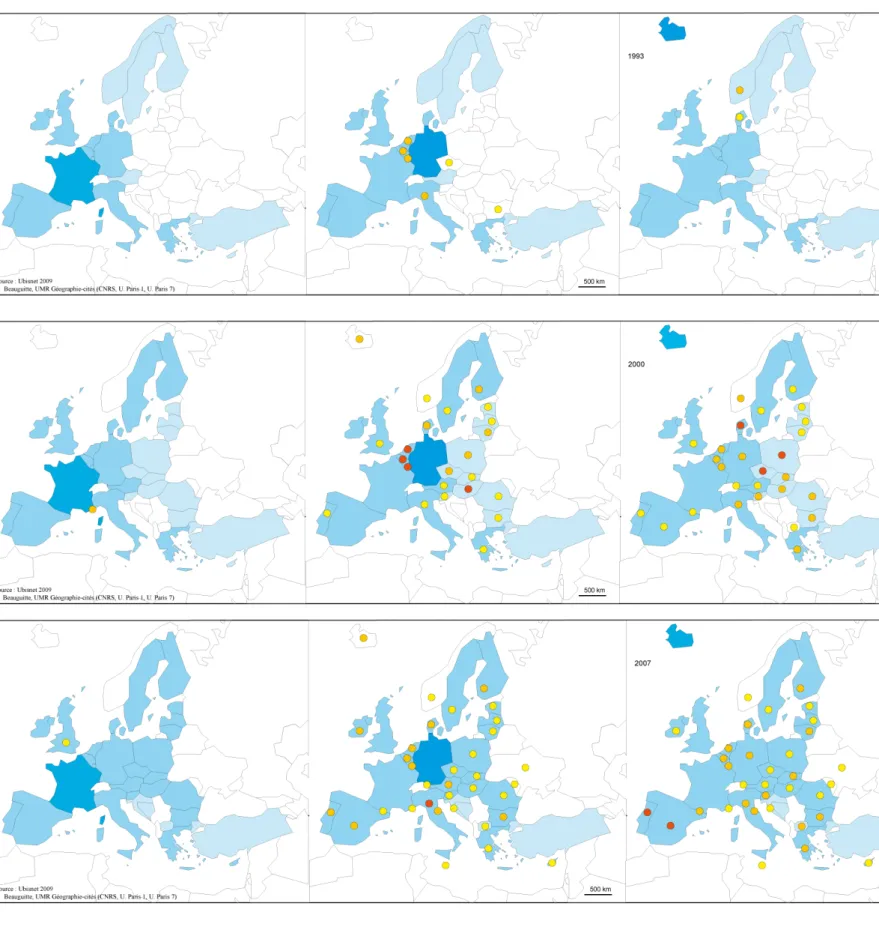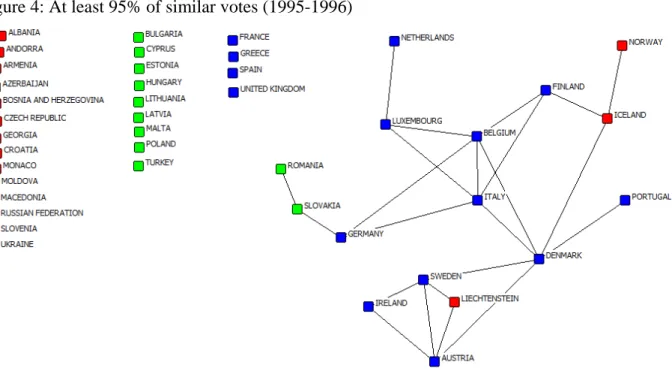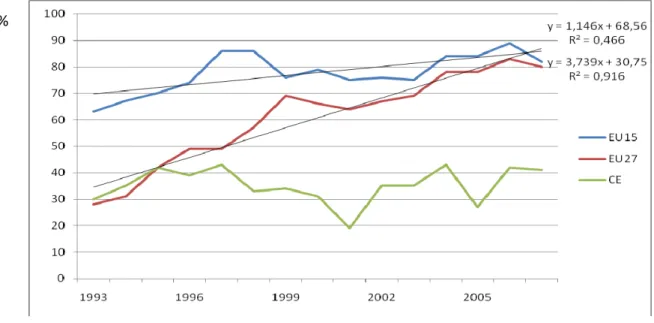HAL Id: halshs-00417679
https://halshs.archives-ouvertes.fr/halshs-00417679
Submitted on 16 Sep 2009HAL is a multi-disciplinary open access archive for the deposit and dissemination of sci-entific research documents, whether they are pub-lished or not. The documents may come from teaching and research institutions in France or abroad, or from public or private research centers.
L’archive ouverte pluridisciplinaire HAL, est destinée au dépôt et à la diffusion de documents scientifiques de niveau recherche, publiés ou non, émanant des établissements d’enseignement et de recherche français ou étrangers, des laboratoires publics ou privés.
Multiscalar approaches of voting behaviour of European
countries in the United Nations General Assembly
Laurent Beauguitte
To cite this version:
Laurent Beauguitte. Multiscalar approaches of voting behaviour of European countries in the United Nations General Assembly. 5th ECPR (European Consortium for Political Research) General Con-ference, Sep 2009, Potsdam, Germany. �halshs-00417679�
Multiscalar approaches of voting behaviour of European countries in the
United Nations General Assembly
(draft version)
Laurent BEAUGUITTE beauguittelaurent@parisgeo.cnrs.fr (Géographie‐cités (GC) CNRS : UMR8504 – Université Panthéon‐Sorbonne ‐ Paris I –
Université Denis Diderot ‐ Paris VII, France)
Paper presented at the 5th ECPR (European Consortium for Political Research) General Conference, Potsdam (Germany), 10-12 septembre 2009.
Abstract
: To test convergence between European Union member states at the United Nations, several analysis are made at different scales. Instead of taking the European Union existence as a starting point, it is here considered as a hypothesis that needs to be confirmed. Using cartography and social network analysis, it shows that the so-called convergence appears at a larger scale than the EU, and that a couple of member states remain apart from this convergence.Key words
: Cartography, European Union, Social Network Analysis, United Nations General Assembly, Voting behaviourThe research leading to these results has received funding from the European Community's Seventh Framework Programme (FP7/2007-2013) under grant agreement n°225260. (www.eurobroadmap.eu)
Introduction
Studying states voting behaviour at the United Nations General Assembly (UNGA) is usual in certain academic fields and in certain countries. Quite strangely, France and geographers (French but not only) showed little interest to this question. From a geographical point of view, this topic appears as a fascinating playground to examine the evolution of the world-system by using quantitative methods.
Since the sixties, many mathematical methods (factorial analysis, hierarchical clustering, multidimensional scaling etc.) were used to highlight regional effects at the UNGA1. The interest for the European Union (EU) is more recent2 but the last years are marked by an impressive academic production related to this topic3. But geographers remain quite silent. Our main hypothesis is that UNGA is a powerful tool for political geography to describe and try to explain the contemporary world.
1
The bibliography is too important to be extensively quoted. Getting a small historical approach can be done with ALGER C., 1970, « Research on Research: A Decade of Quantitative and Field Research on International Organizations », International Organization, vol.24, n°3, p.414-450, HAAS E., ROWE E., 1973, « Regional Organizations in the United Nations: Is there Externalization? »,
International Studies Quarterly, vol.17, n°1, p.3-54, HOLLOWAY S., TOMLINSON R., 1995, « The
New World Order and the General Assembly: Bloc Realignment at the UN in the Post-Cold War World », Canadian Journal of Political Science / Revue canadienne de science politique, vol.28, n°2, p.227-254, NEWCOMBE H., ROSS M., NEWCOMBE A., 1970, « United Nations Voting Patterns »,
International Organization, vol.24, n°1, p.100-121.
2
Except FOOT R., 1979, « The European Community’s Voting Behaviour at the United Nations General Assembly », Journal of Common Market Studies, vol.17, n°4, p.350-360 and HURWITZ L., 1976, « The EEC in the United Nations: The Voting behaviour of Eight Countries, 1948-1973 »,
Journal of Common Market Studies, vol.13, p.224-243, HURWITZ L., 1976, « The EEC and
Decolonization: The Voting behaviour of the Nine in the UN General Assembly », Political Studies, vol.24, n°4, p.435-447
3
See for example FASSBENDER B., 2004, « The Better Peoples of the United Nations? Europe’s Practice and the United Nations », European Journal of International Law, vol.15, n°5, p.857-884; JOHANSSON-NOGUES E., 2004, « The Fifteen and the Accession States in the UN General Assembly: What Future for European Foreign Policy in the Coming Together of the ‘Old’ and the ‘New’ Europe », European Foreign Affairs Review, vol.9, p.67-92, LAATIKAINEN K., SMITH K. (ed.), 2006, The European Union at the United Nations. Intersecting Multilateralisms, Baginstoke, Palgrave Mac Millan, ORTEGA M. (ed.), 2005, The European Union and the United Nations.
Partners in effective multilateralism, Paris, Institute for Security Studies, Chaillot Paper n°78,
WOUTERS J., 2007, « The United Nations and the European Union: Partners in Multilateralism »,
This paper aims to apply on this subject one of the most important geographical concept, the concept of scale4. A phenomena existing at one particular scale (e.g EU) can perfectly be the reflection of a phenomena existing at a larger scale (e.g. Council of Europe). For example, the official website of the EU claims that the convergence between member states at the UNGA is so high that EU can “speak with one voice”. Nevertheless, you could perfectly imagine that this convergence is a global process between all European states or inside all regional organizations (ASEAN, Mercosur etc.).
This paper is organised in three parts. The first part deals with the data and the methodology chosen. The second part considers the global evolution of voting behaviour between 19855 and 2007. The final part studies the European convergence at four different scales (National behaviour, EU 15, EU 27, Council of Europe).
Data choice and treatment
Many options are possible for the data’s choice. The simplest solution – consider all votes and all countries – is never used, as far as we know, for several reasons. First, partial votes (votes on a word, a sentence or a paragraph) bring many redundancies6. Second, many votes regarding disarmament or Palestine are nearly unanimous and keeping them would only reinforce the marginal situation of Israel and United States at the UNGA. Regarding countries, an option often chosen is to eliminate countries to do not participate to the vote on a given threshold (generally greater or equal to 30%). This option can be discussed. It is possible to consider that absent states share some particularities (failed states, war, Least Developed Countries) and form a sort of group by default.
I kept all votes on resolution where the YES does not overtake 95% of the vote cast. I also kept all countries, whatever is the ‘do not participate’ percentage. Members temporally
4
BRUNET R., FERRAS R., THERY H., 1992, Les mots de la géographie, dictionnaire critique, Montpellier/Paris, RECLUS/La Documentation Française ; LEVY J., LUSSAULT M. (dir.), 2003,
Dictionnaire de la géographie et de l’espace des sociétés, Paris, Belin ; TAYLOR P.J., 1977, Quantitative Methods in Geography. An Introduction to Spatial Analysis, Prospect Heights, Waveland
Press
51985 means the session 1985-1986. I used the same convention all along this paper.
6
excluded from the UNGA are not taken into account (e.g. South Africa before the abolition of apartheid).
The period studied goes from 1985 until 2007. Starting a couple of years before the Berlin wall fall provides a useful counterpoint to the present situation.
Per session, I created an Excel sheet with countries on rows and resolutions on columns. Then this table was transformed in a similarity matrix giving the percentage of similar votes between each pair of countries.
This method might seem too simple because the distance is not properly evaluated between countries. Let’s consider three countries A, B and C voting on a resolution; A votes YES, B abstains and C votes NO. With this method, the political distance between A and b is the same than between A and C (0% of similar votes). However, we can consider that B is closer to A than C. Many methods were proposed7 but all stumbled on an obstacle; how consider the ‘do not vote’? It is a real problem because the meaning itself of this choice changed the last years; it used to be a ‘soft’ no8, it became during the last sessions a proof of absence.
On the other hand, results obtained with this simple and understandable method are not significantly different from the results we get with more sophisticated one.
Of course, this method is mainly a descriptive one. It should be considered as a preliminary step before a more thematic and qualitative analysis (text of resolution, explanation of votes etc.).
The global situation
The UNGA is here considered as a dynamic system. Relations between actors take place in a global arena and, before studying a particular group, studying the UNGA as a whole seems important.
Comparisons can be misleading if we forget to consider two complementary facts; First, the number of UNGA members increases during the last years (159 in 1985, 179 in 1992, 192 today). Second, the number of votes studied, on contrary, decreases during all the period (126
7 See for example the index proposed by LIJPHART A. in 1963 (« The Analysis of Bloc Voting in the
General Assembly: A Critique and a Proposal », The American Political Science Review, vol.57, n°4, p.902-917) that is still useful today.
8 This evolution is clearly appearing when we consider votes on human rights in a given country.
in 1985, 46 in 1992 and 53 in 2007). A way to avoid this problem is to use a tool frequently used in ‘Social Network Analysis’, density9. A graph is told complete when all possible links between actors are present and the density is then equal to 1. When the number of nodes increases, the density tends to decreases – getting all possible links between 5 actors is more common than with 100. As the graphs considered are not directed (if A votes like B then B votes like A), density d is calculated this way:
N = number of nodes L = number of links
The following graphs show the relational links between UNGA members in 1985 and 2005 when 10% of all possible links remains – it represents 88% of similar votes in 1985 and 91% of similar votes in 2005. Colour of nodes is related with the regional group10. Isolate nodes were deleted to improve the readability of the figure.
9
See FREEMAN L., 2005, « Graphical Techniques for Exploring Social Network Data” in CARRINGTON P., SCOTT J., WASSERMAN S. (eds), Models and Methods in Social Network
Analysis, Cambridge, Cambridge University Press and WASSERMAN S., FAUST K., 1994, Social Network Analysis. Methods and applications, Cambridge, Cambridge University Press
10
Colours used are black for the African group, yellow for the Asian Group, green for Latin American and Caribbean Group, blue for Western European and others groups and red for Eastern European Group. Countries that don’t belong to a regional group are in white (in 2007, Kiribati and United States).
Figure 1: A dynamic world system 1, density 10% in 198511
Source: Ubisnet
Two groups clearly appear; the Non Aligned Movement (note the presence of Cyprus, Malta and Yugoslavia) and, partially linked to the first one via Nicaragua and Syria, the socialist group. Only a couple of links joins the different EU member states. A part of the Nordic group is also present. The regional aspect of these linkages is clearly apparent for some of these sub graphs.
11
The algorithm used by the software package (Netdraw) puts together nodes that get the same behaviour. The larger is the distance on the graph, the greater is the political distance between two states.
Figure 2: A dynamic world system 2, density 10% in 2005
Source: Ubisnet
Twenty years later, the situation is completely different. The group located on the bottom right is the nonvoting one (Chad, Kiribati etc.). European countries become an impressive interconnected sub graph including Cyprus and Malta (and New Zealand!). A reason that can partially explain this expansion is simply the rising number of European countries (Baltic countries, Czech Republic and Slovakia, implosion of Yugoslavia, entrance of Andorra, Liechtenstein, Monaco, San Marino and Switzerland). The Non Aligned Movement block is less compact than it used to be and a slow process of regionalization regarding South America seems to appear.
To sum up, on a world scale, a convergence appears between European states, including European Union, and revealed by an impressive interconnected sub graph. In the following part, we focus at different scales on Europe itself.
A European convergence? Or a European Union one?
If convergence is so high between EU member states, as EU officials claim it, it seems possible to make a small cartographic experience. Just by looking figure 3, the aim of the game is to guess which of these three countries are parts of EU.
Of course, the choice of countries is partially arbitrary. Anyway, it seemed interesting to study the ‘Franco-German couple’; their importance in the EU construction can hardly be contested. Two complementary information are mapped; the institutional situation of the country regarding the EU (member, agreed candidate, other) and the percentage of similar votes with one state used as a reference. This last point has to be clarified; it doesn’t mean for example that in 1993 Italy votes like Germany (or that Germany votes like Italy). Taking a state of reference is simply a way to get an understandable map, but the only comment possible is Germany and Italy in 1993 share at least 95% of similar votes.
It appears that France has its own national diplomatic strategy at the UNGA. Votes on nuclear issues explain this particularity and results would have been identical with United Kingdom. Both are nuclear powers, both get a permanent seat at the Security Council and both seem to believe they can have their own place in the world system.
The German diplomacy is completely different. Convergence with Southern, Nordic and Eastern Europe is obvious. The case of Iceland presents many similarities with the German one. From a diplomatic point of view, at the UNGA, Iceland could perfectly be a EU member state.12
Two geographical limits clearly appear; Mediterranean Sea on the South side, Russia and Turkey on the Eastern front.
12
I made these maps before the Icelandic candidacy. However, you get very similar maps, at least regarding the number of dots, with Andorra, Liechtenstein or Norway.
Changing scale allows completing these first observations. The following graphs show the relations between the 43 members of the Council of Europe. Choosing an institutional group allows avoiding ad hoc group creation (UE + Norway + Iceland etc.). To get comparable results, the period studied is shorter and only states that belongs to the Council of Europe and to the UNGA from 1993 until 2007 are considered.
The rising convergence between nearly all member states – and its neighbours – clearly appears and so the marginal position already mentioned of France and United Kingdom13. Another interesting fact is the evolution of Cyprus and Malta. Until the end of the 1990’s, they both used to vote with the Non Aligned Movement – both are members of it, and Cyprus is now the only EU member state which is also member of the Asian Group at the UNGA. In the last years, their positions are becoming more and more ‘European compatible’.
Figure 4: At least 95% of similar votes (1995-1996)
Blue nodes: European Union member states Green nodes: candidates
Red nodes: others
Source: Ubisnet
Density in the graph above is extremely low: only 2.5% of all possible nodes are present.
13
Concerning the French diplomatic strategy, see LEQUESNE C., 2008, La France dans la nouvelle
Figure 5: At least 95% of similar votes (2005-2006)
Source: Ubisnet
In figure 5, the density reaches 25% of all possible links. Spain and Greece are now connected but each with one link only. France and United Kingdom remain isolated, like Turkey. The core of the graph contains a majority of EU member states but both candidates and other states are also present.
The figure 6 provides a synthesis on graph density at three different scales.
When we consider EU 15, unanimity rises slowly until 1998 and then remains stable around 80%. That means that, when we consider the graph of relations at the threshold of 80%, all member states are linked together (complete graph). More interesting is the aspect of the curve EU 27. The convergence is rising much more quickly and the relation is a linear one (r2 = 0.916). New member states seem to adopt the European Union voting behaviour quite easily. On contrary, this type of process does not concern the Council of Europe. It seems obvious that Russia and some of its neighbours have a radically different diplomacy at the UNGA.
Figure 6: percentage of similar votes where density of links becomes less than 1
Source: Ubisnet
Conclusion
The convergence between some European Union member states and some others European states clearly exists at the UNGA. It is of course possible to explain that its neighbours adopt EU positions but it seems harder to prove it. When topics of votes are taken into account, a trivial fact appears. Unanimity is often possible because some votes do not have any consequence. On contrary, when a vote implies national consequences, then unanimity vanishes. National strategy of France and United Kingdom clearly illustrates this position. Of course, a thematic approach is clearly needed to complete these methods. A further step is to link these results that mix all types of resolutions with a thematic approach. Preliminary cartographic tests on votes dealing with situation of human rights give interesting results.
Further reading
BADIE B., DEVIN G . (dir.), 2007, Le multilatéralisme. Nouvelles formes de l’action internationale, Paris, la découverte
BELOT C., MAGNETTE P., SAURUGGER S. (dir.), 2008, Science politique de l’Union européenne, Paris, Economica
CHARILLON F. (dir.), 2002, Politique étrangère. Nouveaux regards, Paris, Presses de Science Po %
GOTTMAN J., 1952, La politique des Etats et leur géographie, Paris, Armand Colin. LAIDI Z., 2008 (2ième éd.), La norme sans la force, Paris, Les Presses de Sciences Po MORIN Edgar., 1987, Penser l'Europe, Paris, Gallimard
ORBIE J., TORTELL L. (ed.), 2009, The European Union and the Social Dimension of Globalization.
How the EU influences the world, London/New York, Routledge
PETITEVILLE F., 2006, La politique internationale de l’Union européenne, Paris, Presses de Science Po
RAFFESTIN C., 1980, Pour une géographie du pouvoir, Paris, LITEC.





